Marulanda J.M. (ed.) Electronic Properties of Carbon Nanotubes
Подождите немного. Документ загружается.


Electronic Band Structure of Carbon Nanotubes
in Equilibrium and None-Equilibrium Regimes
395
But we don’t have u
k
(r). Therefore, we don’t know the exact form of ψ
k
(r). There are a
variety of methods to describe the interaction of electron and the crystal lattice. In this
chapter we investigate the mentioned interaction according to nearest neighbor π-Tight
Binding (π-TB) and the third neighbor π-TB method.
3.2 Brillouin zone
Suppose that we have a wave function of the form e
iG.r
. We want to find G vector such that
()i
i
ee
G. r+R
G.r
(12)
or:
2 l
G.R
(13)
where l is an arbitrary integer. Now regarding the following equations for G and R:
123
ˆˆˆ
ggg
123
Gk k k
(14a)
123
ˆˆˆ
nnn
123
Ra a a
(14b)
where
ˆ
1
a ,
ˆ
2
a ,
ˆ
3
a are unit vectors in lattice space and
ˆ
1
k ,
ˆ
2
k ,
ˆ
3
k are unit vectors in, so called,
“reciprocal lattice” space. If we apply (13) we will have:
11 22 33
2 n
g
n
g
n
g
G.R
(15)
which suggests that:
ˆˆˆ
ˆˆˆ
200
ˆˆ ˆ
ˆˆ ˆ
02 0
ˆˆˆ
ˆˆˆ
002
11 12 13
21 22 21
31 32 33
k.a k.a k.a
k.a k.a k.a
k.a k.a k.a
(16)
Solving above equations [8]:
2
ˆˆ
ˆ
2
ˆˆ ˆ
13
1
13
aa
k
a.a a
(17a)
2
ˆˆ
ˆ
2
ˆˆ ˆ
31
2
13
aa
k
a.a a
(17b)
2
ˆˆ
ˆ
2
ˆˆ ˆ
12
3
13
aa
k
a.a a
(17c)
Now we have unit vectors of the reciprocal lattice. In order to get the Brillouin zone we
should we should apply the following condition:
2
2
k-G k
(18a)
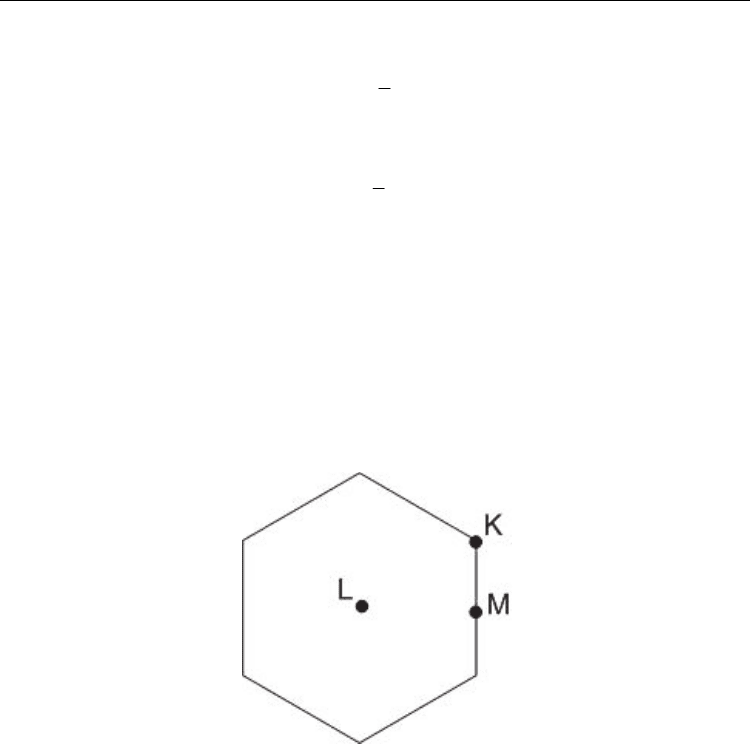
Electronic Properties of Carbon Nanotubes
396
or:
2
1
2
k.G G
(18b)
thus:
1
2
kG
(18c)
Using (18-c) we can draw the borders of the Brillouin zone. The inner most area is called the
first Brillouin zone and hence, simply it is called “Brillouin zone”.
Now we return to our lattice which is graphene sheet, a two dimensional crystal. If we write
(16) for this kind of lattice we will have:
20
02
11 12
21 22
k.a k.a
k.a k.a
(19)
From (19) it is clear that k
1
and k
2
are perpendicular to a
2
and a
1
respectively. Having a
1
and
a
2
from Fig. 1(a) we can easily find k
1
and k
2
and draw the Brillouin zone (Fig. 3).
Fig. 3. The Brillouin zone for the graphene lattice is illustrated. L, K and M are high
symmetry points.
As mentioned earlier, theoretically, SWCNT can be considered as a graphene lattice that is
rolled over into a cylinder. Thus, according to Fig. 1(b) we catch up the following:
()
() ()
i
i
ue ue
k. r+C
k.r
kk
rr
(20)
Therefore [9]:
2
l
k.C
(21)
where
l is again, an arbitrary integer. This boundary condition which is so called, “Born-von
Karman” condition, makes the Brillouin zone to be quantized. Fig. 4 shows this fact. At this
point we can begin our investigation about the band structure of SWCNT.
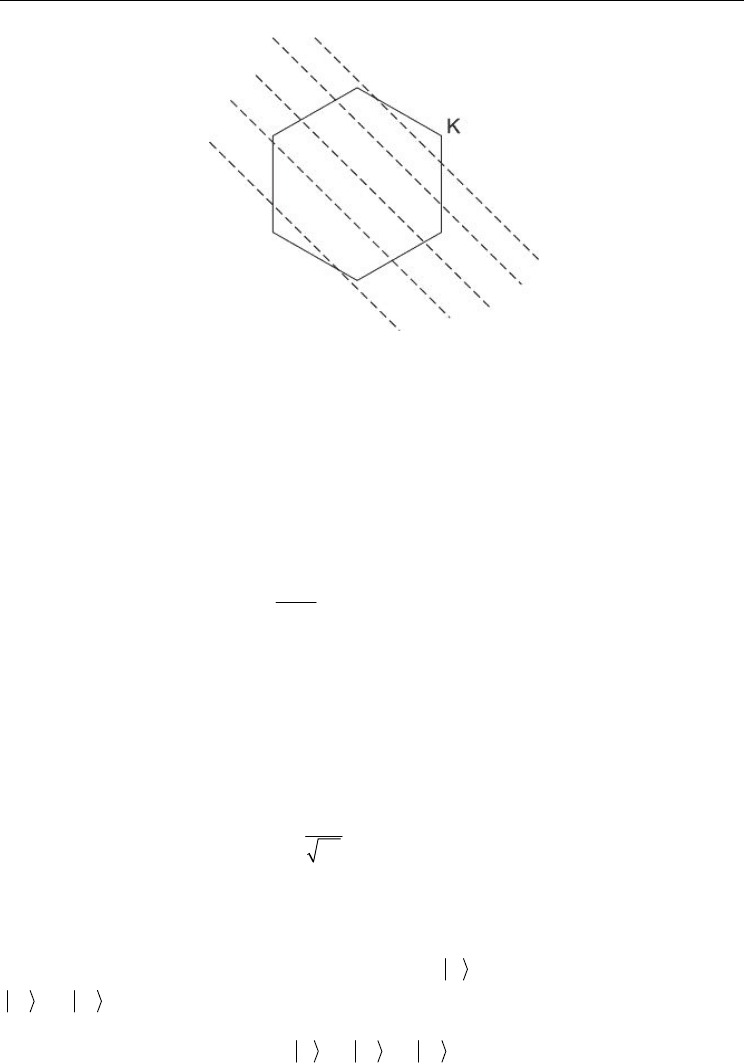
Electronic Band Structure of Carbon Nanotubes
in Equilibrium and None-Equilibrium Regimes
397
Fig. 4. The Born-von Karman condition makes the SWCNT’s Brillouin zone to be quantized.
3.3 Tight-binding approximation
As mentioned, there are many methods and approximations that are used to investigate the
electronic band structure of a solid. In this section we use the tight-binding approximation.
In this approximation we consider the wave function of an electron as the Linear
Combination of Atomic Orbitals and hence the method is also called as LCAO.
As is known, the energy of an electron can be estimated using Schrödinger’s equation as
follows:
22
() () ()
2
VE
m
kk
rr r
(22)
where m is the mass of an electron and
()
k
r is the wave function of a single electron with
the wave vector k. Now
()
k
r is written as the following:
() ()c
kkrkr
r
rr
(23)
where
()
kr
r ’s are basis functions that are made from atomic orbitals as:
1
() ( )
i
unitcells of
t
thesystem
e
N
k.R
kr r
rR-r (24)
where N
t
is the total number of unit cells in the system. We regard the single 2p
z
orbital of
the carbon atoms to used in (23); besides, we take into account the interaction of the nearest
neighbor atoms (Fig. 5), because they have the most important role in formation of the
energy states [10]. We write the wave function
in terms of basis functions,
1
and
2
as the following:
11 22
cc
(25)
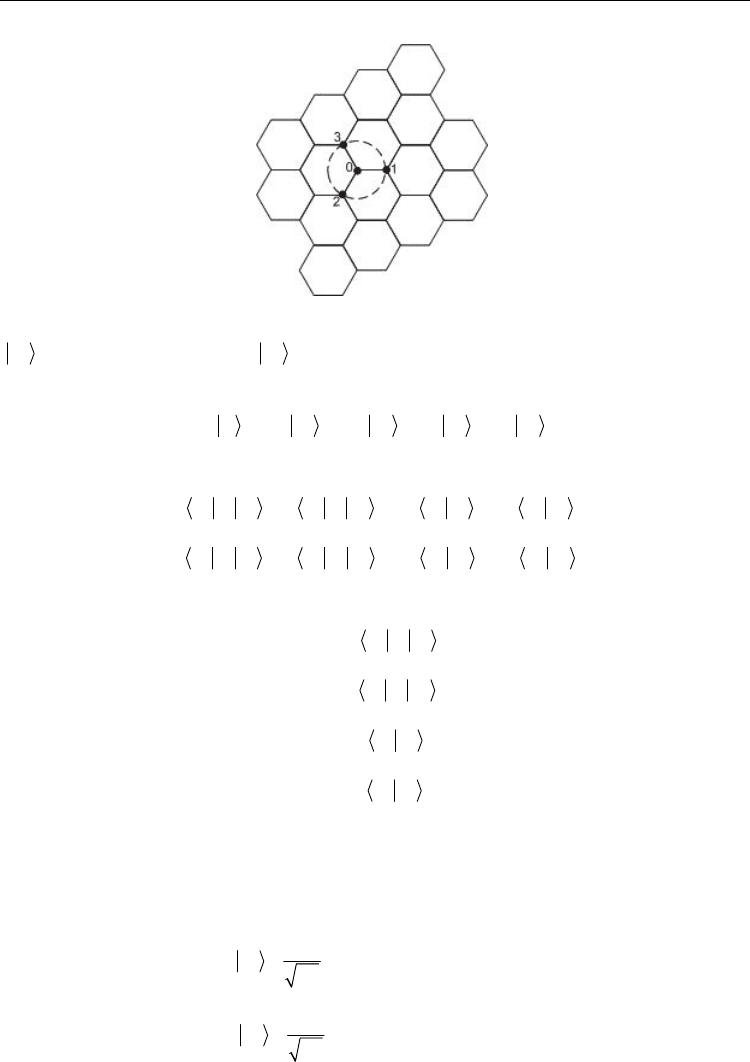
Electronic Properties of Carbon Nanotubes
398
Fig. 5. In this figure the nearest neighbor atoms with respect to atom 0 are illustrated.
1
corresponds to atom 0 and
2
corresponds to atoms 1, 2 and 3 in Fig. 5.
Now applying
(22) to (25) yields:
11221122
HcH cH cEcE
(26)
and consequently:
11 1 21 2 1 11 2 12
cH cH cE cE
(27a)
12 1 22 2 1 21 2 22
cH cH cE cE
(27b)
Now, we define the following values:
11AA
HH
(28a)
12AB
HH
(28b)
11AA
S
(28c)
12AB
S
(28d)
then (27-a) becomes:
12
()()0
AA AA AB AB
c H ES c H ES
(29)
knowing that:
1
1
()
A
i
A
Latticesite A
t
e
N
k.R
r
r-R (30a)
2
1
()
B
i
B
LatticesiteB
t
e
N
k.R
r
r-R
(30b)
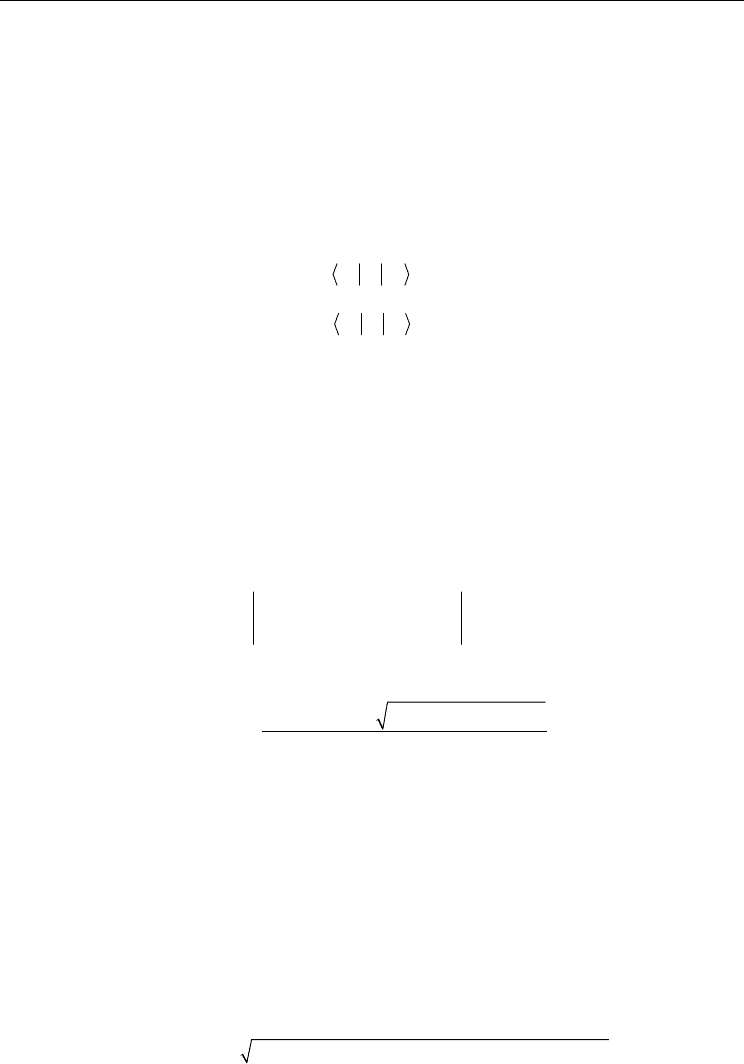
Electronic Band Structure of Carbon Nanotubes
in Equilibrium and None-Equilibrium Regimes
399
Replacing (30-a) and (30-b) in (28-a) to (28-d) yields:
2
A
Ap
H
(31a)
3
2
()
i
ii
A
B
pp
He e eV
1
11 1
k.R
k.R k.R
(31b)
1
AA
S
(31c)
3
2
0
()
i
ii
AB
Se e es
1
11 1
k.R
k.R k.R
(31d)
22BB AA
HHH
(31e)
*
21BA AB
HHH
(31f)
1
BB AA
SS
(31g)
*
BA AB
SS (31h)
which make (27-b) to become:
**
12
()( )0
AB AB AA AA
c H ES c H ES
(32)
considering (29) and (32) together; to have a non trivial solutions for
c
1
and c
2
we should
have:
**
0
AA AA AB AB
AB AB AA AA
HESHES
HESHES
(33)
Solving (33) for
E [11]:
2
01 01 23
3
(2 ) (2 ) 4
()
2
EE EE EE
E
E
k
(34)
where:
0
A
AAA
EHS
(35a)
**
1
A
BAB ABAB
ESH HS
(35b)
2*
2
A
AABAB
EH HH (35c)
2*
3
A
AABAB
ES SS (35d)
Neglecting the overlap of 2p
z
orbitals of atomic neighbors, S
AB
, we get:
( ) 3 2cos( ) 2cos( ) 2cos( ( ))
pp
EV
12 12
kk.ak.ak.aa (36)
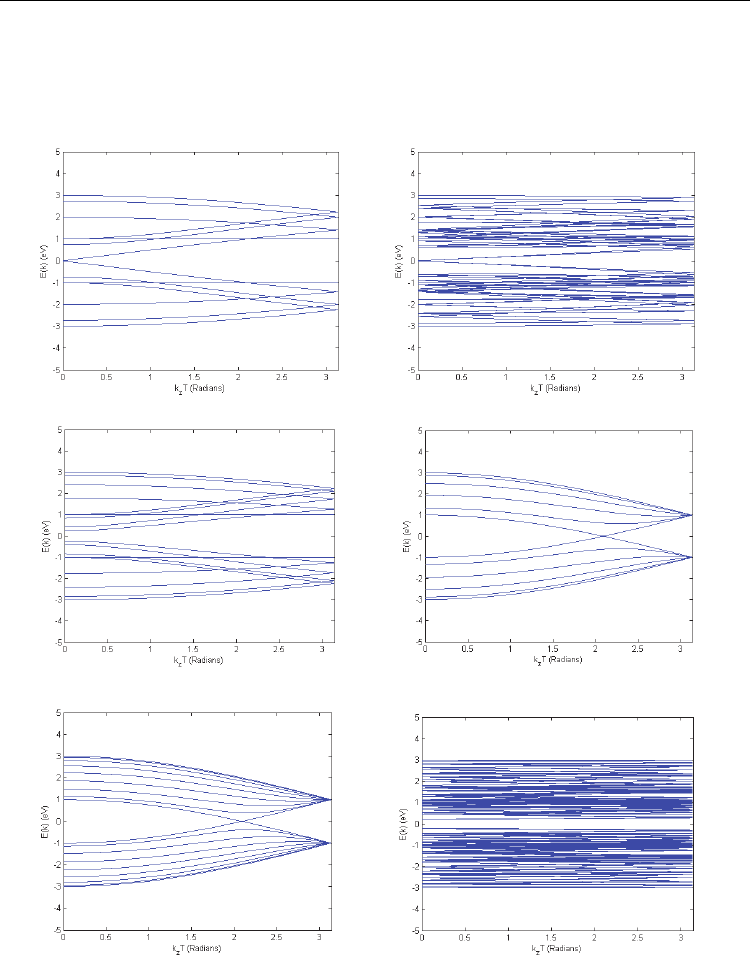
Electronic Properties of Carbon Nanotubes
400
Now applying Born von-Karman boundary condition (equation (21)) to (36) one can draw
the energy diagram or the electronic band structure of SWCNT. Illustrated in Fig. 6(a) to 6(f)
are the electronic band structures for several chiral vectors. At this step of our work, it is
necessary to mention a few points. First of all, according to their chiralities, SWCNTs are
(a) (b)
(c) (d)
(e) (f)
Fig. 6. The electronic band structures of several nanotubes according to (36) are illustrated.
(a) is the electronic band structure of chiral vector (6,0), (b) (6,3), (c) (8,0), (d) (5,5), (e) (8,8),
(f) (5,4)

Electronic Band Structure of Carbon Nanotubes
in Equilibrium and None-Equilibrium Regimes
401
roughly divided to three classifications. A nanotube with chirality of (n,0) is called a “zig-
zag” nanotube. A nanotube with chirality of (n,n) is called an “armchair” nanotube and a
nanotube without the two mentioned chiralities, is called a “chiral” nanotube. As examples,
illustrated in Fig. 6(a) and (c) are the band structure of SWCNTs with chiral vectors (6,0) and
(8,0) which are zig-zag nanotubes, and Fig. 6(d) and (e) show the band structure of SWCNTs
with chiral vectors (5,5) and (8,8) which are armchair nanotubes.
As the Second point, it worth noting that, if we examine (36) with Born-von Karman
boundary condition, it is observed that for any chiral vector (n,m) when (n-m) mod 3 is
equal to 0, then the band-gap is equal to zero. Two samples of this type are shown in Fig.
6(a) and (b). It is clear that according to this model armchair nanotubes are of this type. At
early days it was believed that these nanotubes are metallic, but next, the deeper researches
and calculations with other methods and approximations showed that they are “semi-
metallic”[12].
Until now, we have performed our analytic calculations with the two assumptions. First, we
assumed that the overlap of the two nearest neighbors is zero. Second, we assumed that the
2p
z
orbitals of the second and the third neighbors have no participation in formation of the
band structure. However, in the following lines, we take into account the donation of these
neighbors to the formation of the band structure of SWCNT.
Shown in Fig. 7 are the second and the third neighbors of the atom 0 of this figure.
According to this figure, one can write:
2
3
12
11 0
a-a
R-R
(37a)
2
3
21
12 0
a-a
R-R
(37b)
3
12
13 0
a+a
R-R
(37c)
21 0 1 2
R-R a a (37d)
22 0 1
R-R a
(37e)
23 0 2
R-R a (37f)
()
24 0 1 2
R-R a a
(37g)
Now, if we apply the formalism of the tight-binding approach, we catch up the following
formulae:
021 1
[ ( )][1 ( )]
p
Eusu
kk
(38a)
100 220 22
2()( )()2(2)
0
Essf s sg sf
kkk (38b)
22 2
22p1 0 02 2
= [ + u( )] - f( ) –
g
( ) – f(2 )E
kk kk (38c)
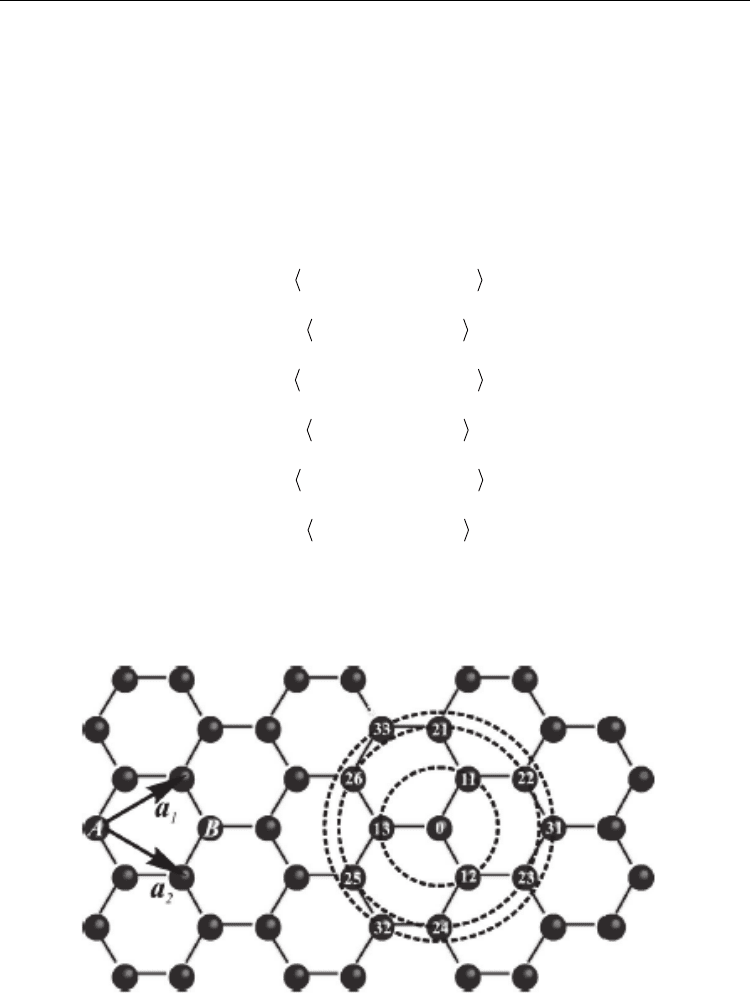
Electronic Properties of Carbon Nanotubes
402
22 2
31 0 02 2
= [1+s u( )] - s f( ) – s s g( ) – s f(2 )E kk k k (38d)
121 2
g
() = 2u() + u(2 -k,k-2k)kkk (38e)
f( ) = 3+u( )kk (38f)
( ) 2cos( ) 2cos( ) 2cos( ( ))u
12 12
kk.a k.a k.aa
(38g)
where the hopping parameters γ
0
, γ
1
, γ
2
and the overlap parameters s
0
, s
1
and s
2
are
introduced as follows:
0
()||( )H
01i
r-R r-R (39a)
0
()|( )s
01i
r-R r-R (39b)
12
()||( )H
0i
r-R r-R (39c)
12
()|( )s
0i
r-R r-R
(39d)
23
()||( )H
0i
r-R r-R (39e)
23
()|( )s
0i
r-R r-R (39f)
Then, (38-a) to (38-g) should be replaced in (34) to get the energy formula. The numerical
values for γ
0
, γ
1
, γ
2
and s
0
, s
1
,s
2
in addition to
a comparison between the results of the
mentioned method with the nearest neighbor π-TB can be found in [13].
Fig. 7. In this figure the nearest neighboring atoms, the second and the third neighboring
atoms are illustrated.
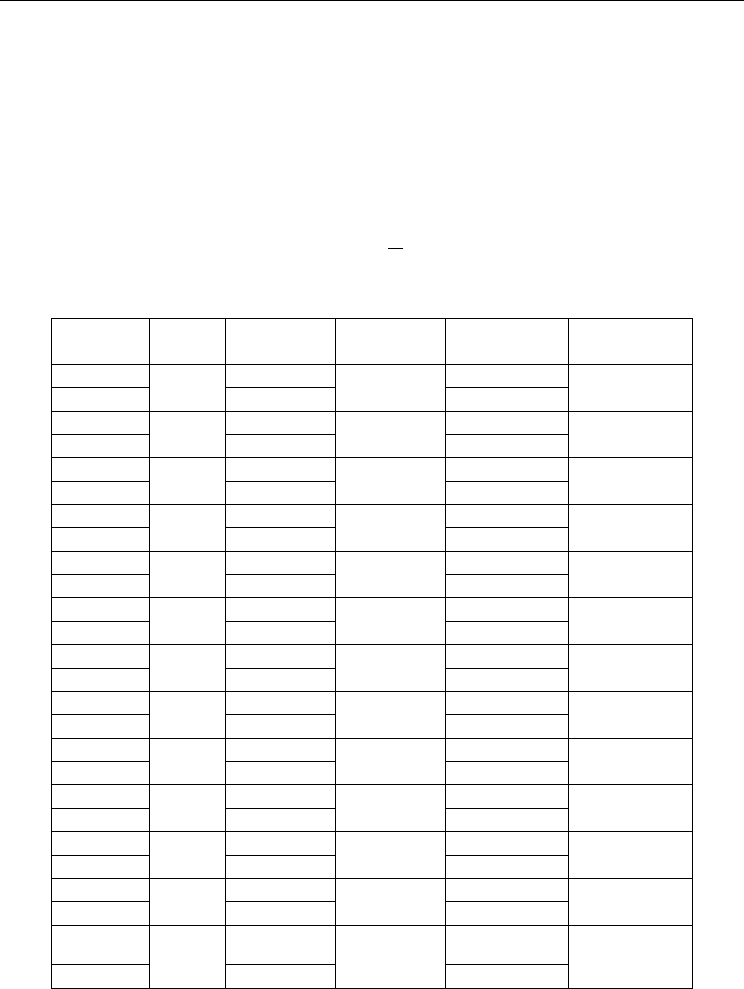
Electronic Band Structure of Carbon Nanotubes
in Equilibrium and None-Equilibrium Regimes
403
At this point, we continue our work by examining some SWCNTs with different chiral
vectors to investigate the effect of radius and chiral angle on the band-gap of these
nanotubes. In Table I we have collected chiral vectors that have the same radii but different
chiral angles to investigate such an effect. In this table from left, the first column shows the
pairs of chiral vectors with the same radii. The second column shows their radii; the third
column, their chiral angle; the forth one, the difference between chiral angles; the fifth
column indicates the energy gap and finally sixth column shows the difference in band-gap
which emanates from the difference between the chiral angle of the nanotubes with the
same radii. As can be seen in this table the effect radius on the band-gap is considerable and
the band-gap is approximately proportional to
1
R
. On the other hand, as can be concluded
from this table, change of the chiral angle has a little effect on the band-gap of SWCNT.
C:(m,n) r (nm)
θ
(Degrees)
|Δθ|
(Degrees)
G (eV) |ΔG| (eV)
(9,1)
0.373
5.20
21.78
1.091448
0.031806
(6,5) 26.99 1.059642
(9,8)
0.576
28.05
17.89
0.694152
0.018414
(13,3) 10.15 0.675738
(14,3)
0.615
9.51
13.17
0.655092
0.010044
(11,7) 22.68 0.645048
(15,2)
0.630
6.17
9.43
0.617706
0.021204
(13,5) 15.60 0.63891
(15,4)
0.679
11.51
15.17
0.593154
0.000558
(11,9) 26.69 0.593712
(18,2)
0.746
5.20
21.78
0.5219532
0.0054126
(12,10) 26.99 0.5273658
(19,2)
0.785
4.94
17.89
0.5116302
0.001953
(14,9) 22.84 0.5135832
(19,3)
0.808
7.22
7.34
0.483786
0.01395
(17,6) 14.56 0.497736
(19,5)
0.858
11.38
9.43
0.4684968
0.0026784
(16,9) 20.81 0.4658184
(23,1)
0.920
2.11
21.78
0.4248612
0.01607
(16,11) 23.89 0.4409316
(23,4)
0.987
7.88
16.42
0.3977982
0.014564
(17,12) 24.31 0.412362
(29,4)
1.221
6.37
21.78
0.322524
0.019139
(19,17) 28.16 0.3416634
(30,4)
1.260
6.17
9.43
0.3167766
0.0071982
(26,10) 15.60 0.3095784
Table 1. A comparison between the effects of the radius and the chiral angle on the band-gap
of SWCNT. In this table G is the band-gap. ΔG is the difference in band-gap of the two
SWCNT with the different chiral angles.
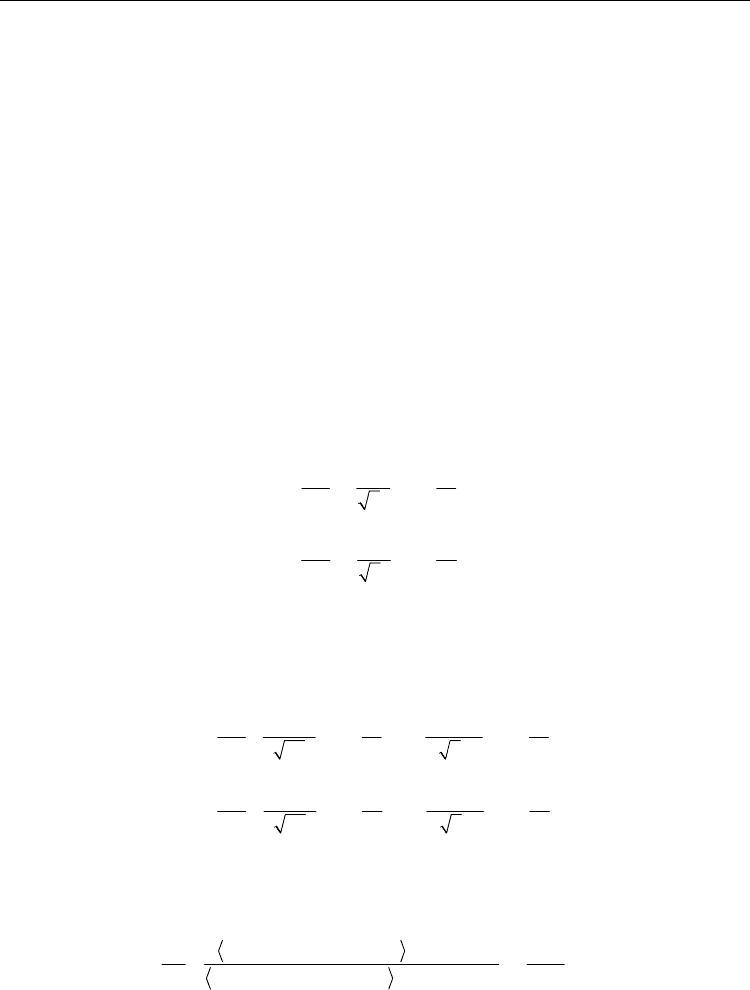
Electronic Properties of Carbon Nanotubes
404
4. The electronic band structure of SWCNTs under non-equilibrium
conditions
4.1 The investigation of the band gap under mechanical strain
In this section of this chapter, we investigate the effect of the two types of mechanical strain,
namely uniaxial (tensile) and torsional strains, by means of the two mentioned
approximations.
If we denote the amount of uniaxial strain by σ
t
, the angle of shear by α and the bonding
lengthes R
11
-R
0
, R
12
-R
0
, R
13
-R
0
by r
1
, r
2
and r
3
respectively, then, under these two type of
strain we have the following relations [14]:
(1 )
it it t
Tensilerr
(40a)
tan( )
ic ic it
Torsionrrr
(40b)
where
r
it
is that part of r
i
that is along the axis of the nanotube (with the unit vector
ˆ
t
) and r
ic
is that part of r
i
that is in azimuthal direction or along the circumference of the nanotube
(with the unit vector
ˆ
c ). In order to use (40-a) and (40-b) we have to express (37) in terms of
ˆ
t
and
ˆ
c :
11
2
1
ˆ
ˆ
22
3
an n
n
d
d
1
rc t (41a)
22
1
1
ˆ
ˆ
22
3
an n
n
d
d
2
rc t (41b)
312
rr+r
(41c)
Using these relations in conjunction with (40-a) and (40-b), we have the following formulae
for r
1
, r
2
and r
3
:
11 1
22
(1 )
tan( )
ˆ
ˆ
22 2
33
t
an n n
nn
d
dd
1
rct
(42a)
22 2
11
(1 )
tan( )
ˆ
ˆ
22 2
33
t
an n n
nn
d
dd
2
rct
(42b)
and (41-c) is still valid. At this step, we are to derive the 3
rd
neighbor π-tight-binding
formulation to investigate the effect of uniaxial and torsional strains. We know that, there is
the following formula for the interaction energy [14]:
2
0
01
()||( )
()||( )
iCC
i
Hwithstrain
a
H without strain r
01i
01i
r-R r-R
r-R r-R
(43)
where a
C-C
is the bond length in the absence of strain and r
1i
with i =1,2,3 is |r
i
| in the
presence of strain. After performing the formal routine of the deriving of the tight-binding
approximation formulae, we find:
